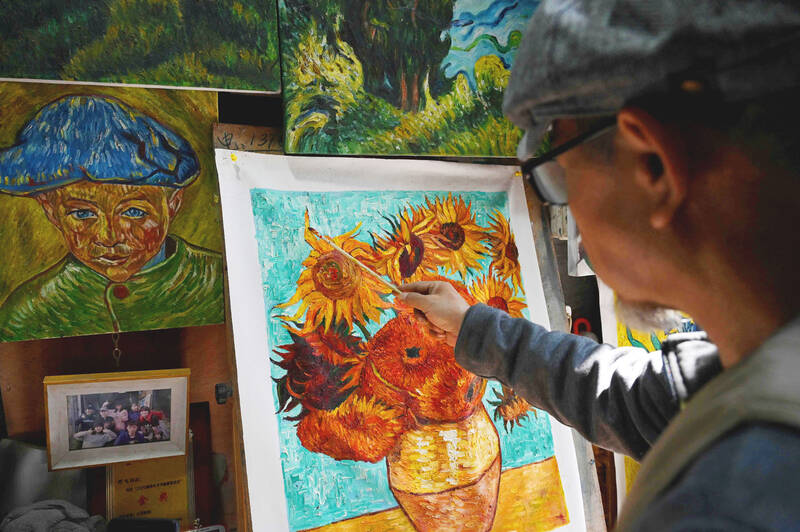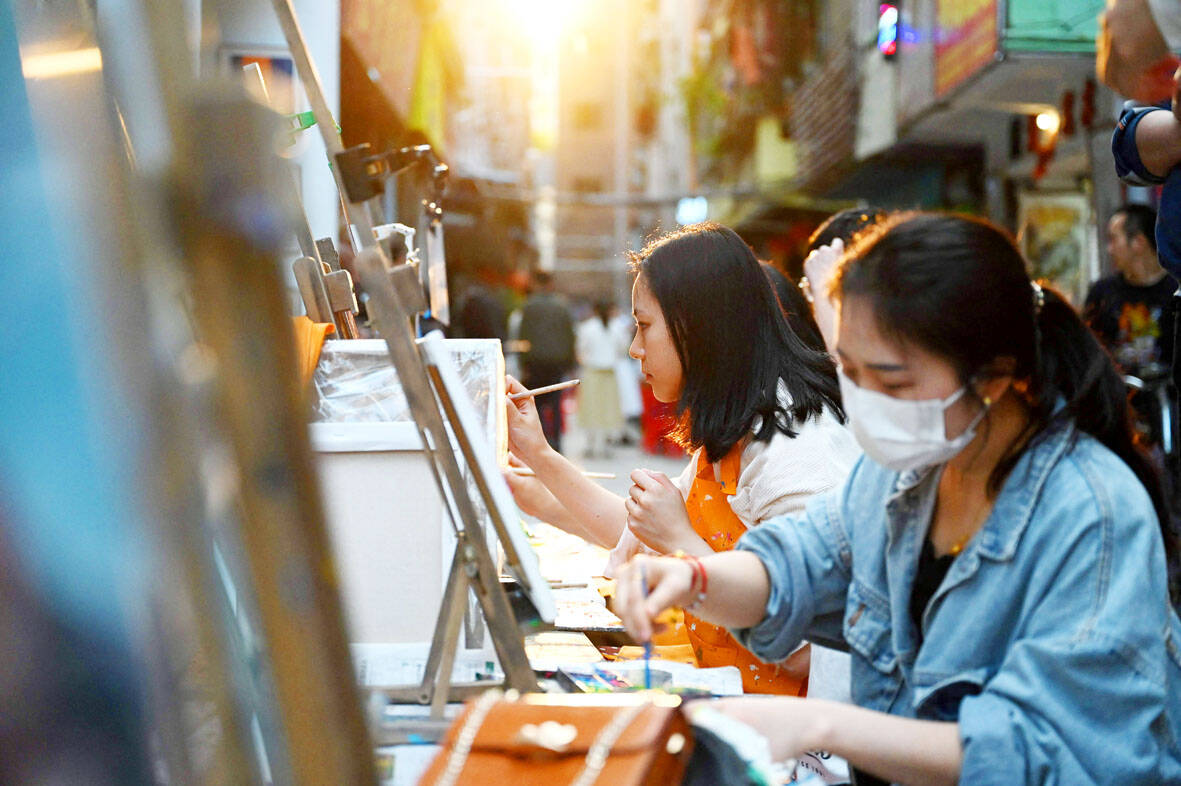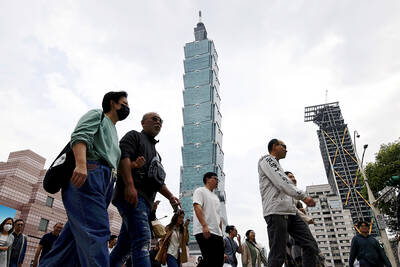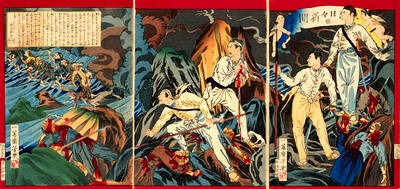Painters in a Chinese village once known for churning out replicas of Western masterpieces are now making original art worth thousands of dollars, selling their own works in a booming domestic art market.
Home to more than 8,000 artists, southern China’s Dafen has been producing near-perfect copies of timeless masterpieces for years.
In its heyday, three out of five oil paintings sold worldwide were made in the village, and for years village painters sold their copies to buyers across Europe, the Middle East and the US.

Photo: AFP
Exports began to dip after the 2008 global financial crisis, and all but dried up when China slammed shut its borders in 2020 because of the coronavirus pandemic.
A few artists gave up and closed their studios. But others saw in the obstacles an opportunity to establish themselves as painters in their own right by catering to China’s art market — the second-biggest in the world, with sales jumping by 35 percent in 2021.
Self-taught artist Zhao Xiaoyong used to sell replicas of Vincent van Gogh’s work for about 1,500 yuan (US$220) each, while his original pieces fetch up to 50,000 yuan, he said.

Photo: AFP
When Zhao moved to Dafen from central China in 1997, his family shared a tiny two-bedroom apartment with five other tenants.
“Those days, there was an assembly line-style system, with each artist painting a small section of a larger piece, like an eye or a nose, before passing the piece to another painter to draw a limb or a shirt sleeve,” he said.
After years of cranking out mock masterpieces, Zhao eventually saved enough money to visit the Van Gogh Museum in Amsterdam and the Saint-Paul Asylum in southern France, where the artist famously painted The Starry Night.
“I felt I could finally enter into his world instead of just copying his brush strokes,” Zhao said.
“I realized I had to come out of Van Gogh’s shadow and give life to my thoughts.”
Now he chronicles how the Dafen oil painting village has changed, using Van Gogh’s style: one canvas shows Zhao in a crowded workshop holding one of the Dutch painter’s self-portraits, while fellow artists nap on their desks.
TOURIST BOOST
Since China’s dismantling of its zero-COVID policy late last year, the streets of Dafen are once again bustling with visitors, crouched in front of easels, slapping paint on canvases.
As well as immersing themselves in the artistic culture with painting lessons, many of the tourists come to buy pieces from the villagers, but their hunt for a good deal is another factor behind the fading market in handmade fakes.
In one alleyway, workers brush paint onto printed canvases of Duccio’s Madonna and Child.
These are sold for a knock-down price as low as 50 yuan per piece, while a hand-painted copy costs up to 1,500 yuan.
“We paint a few strokes over the printed image to make it look like an authentic oil painting,” said one artist, who declined to be named.
“Buyers think the printed background is painted using watercolors.”
‘CHINESE AESTHETIC’
Another Dafen-based artist on a mission to move on from painting imitations is Wu Feimin, who has carved out a niche selling Buddhist-themed art.
“I used to copy Picasso’s work, and now I have my distinct style,” Wu said, painting a giant face of the Buddha with a palette knife.
“It takes weeks, sometimes months, to complete one painting,” the artist said as he was getting ready for exhibitions in the village and the rich industrial hub of Guangzhou.
“It’s risky, but the margins are better.”
Other artists said that they went back to school during the pandemic to learn how to draw mountains and weeping-willow trees seen in traditional Chinese landscape paintings.
“Wealthy Chinese buyers want art that reflects a Chinese aesthetic,” said Yu Sheng, a fine-art teacher who used the opportunity to retrain in the classical style.
While he continues to make ends meet by exporting replicas of Western works, he also creates his own pieces, determined to crack the more lucrative domestic market and become a portrait painter for the wealthy.
And he is confident in his abilities over those of artists from well-known schools.
“Our technique is better because we paint every day, but we don’t have contacts with art dealers in big cities,” he said.
“Our survival depends on whether our work is recognized by China’s art buyers — we must learn to bend like bamboo.”

In the March 9 edition of the Taipei Times a piece by Ninon Godefroy ran with the headine “The quiet, gentle rhythm of Taiwan.” It started with the line “Taiwan is a small, humble place. There is no Eiffel Tower, no pyramids — no singular attraction that draws the world’s attention.” I laughed out loud at that. This was out of no disrespect for the author or the piece, which made some interesting analogies and good points about how both Din Tai Fung’s and Taiwan Semiconductor Manufacturing Co’s (TSMC, 台積電) meticulous attention to detail and quality are not quite up to

April 21 to April 27 Hsieh Er’s (謝娥) political fortunes were rising fast after she got out of jail and joined the Chinese Nationalist Party (KMT) in December 1945. Not only did she hold key positions in various committees, she was elected the only woman on the Taipei City Council and headed to Nanjing in 1946 as the sole Taiwanese female representative to the National Constituent Assembly. With the support of first lady Soong May-ling (宋美齡), she started the Taipei Women’s Association and Taiwan Provincial Women’s Association, where she

Chinese Nationalist Party (KMT) Chairman Eric Chu (朱立倫) hatched a bold plan to charge forward and seize the initiative when he held a protest in front of the Taipei City Prosecutors’ Office. Though risky, because illegal, its success would help tackle at least six problems facing both himself and the KMT. What he did not see coming was Taipei Mayor Chiang Wan-an (將萬安) tripping him up out of the gate. In spite of Chu being the most consequential and successful KMT chairman since the early 2010s — arguably saving the party from financial ruin and restoring its electoral viability —

It is one of the more remarkable facts of Taiwan history that it was never occupied or claimed by any of the numerous kingdoms of southern China — Han or otherwise — that lay just across the water from it. None of their brilliant ministers ever discovered that Taiwan was a “core interest” of the state whose annexation was “inevitable.” As Paul Kua notes in an excellent monograph laying out how the Portuguese gave Taiwan the name “Formosa,” the first Europeans to express an interest in occupying Taiwan were the Spanish. Tonio Andrade in his seminal work, How Taiwan Became Chinese,